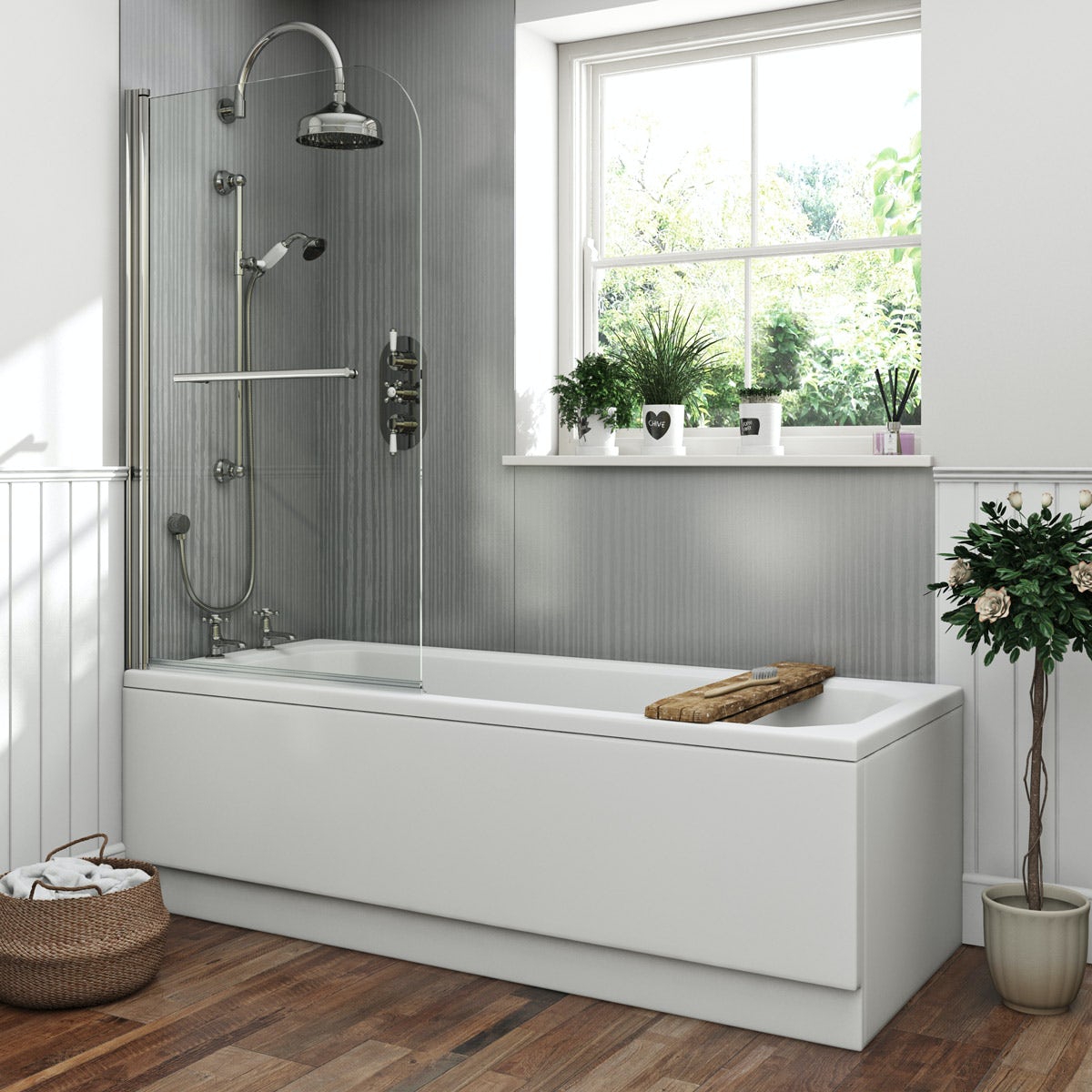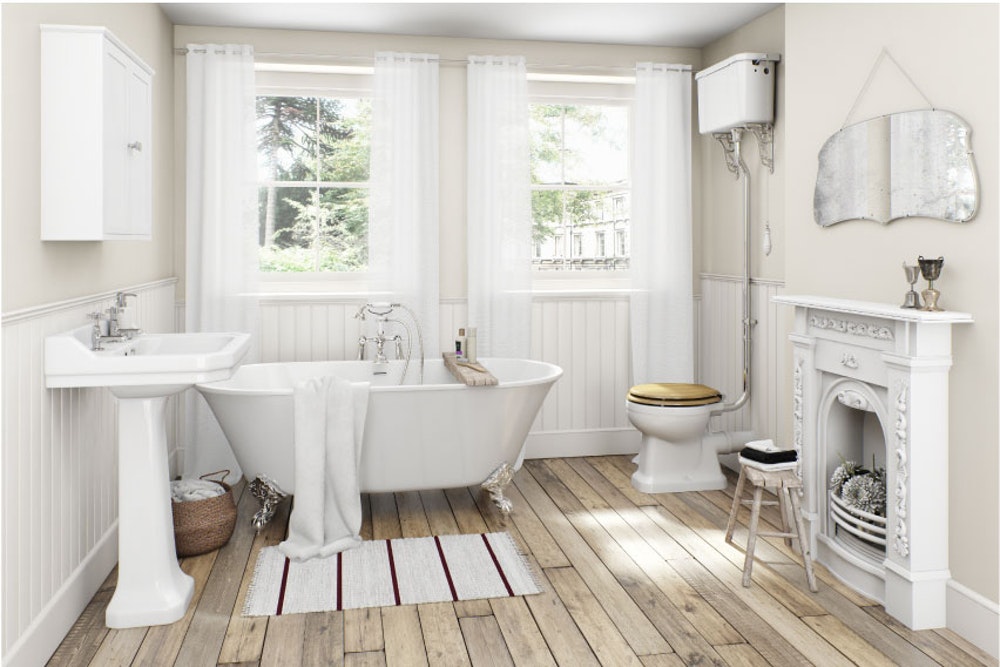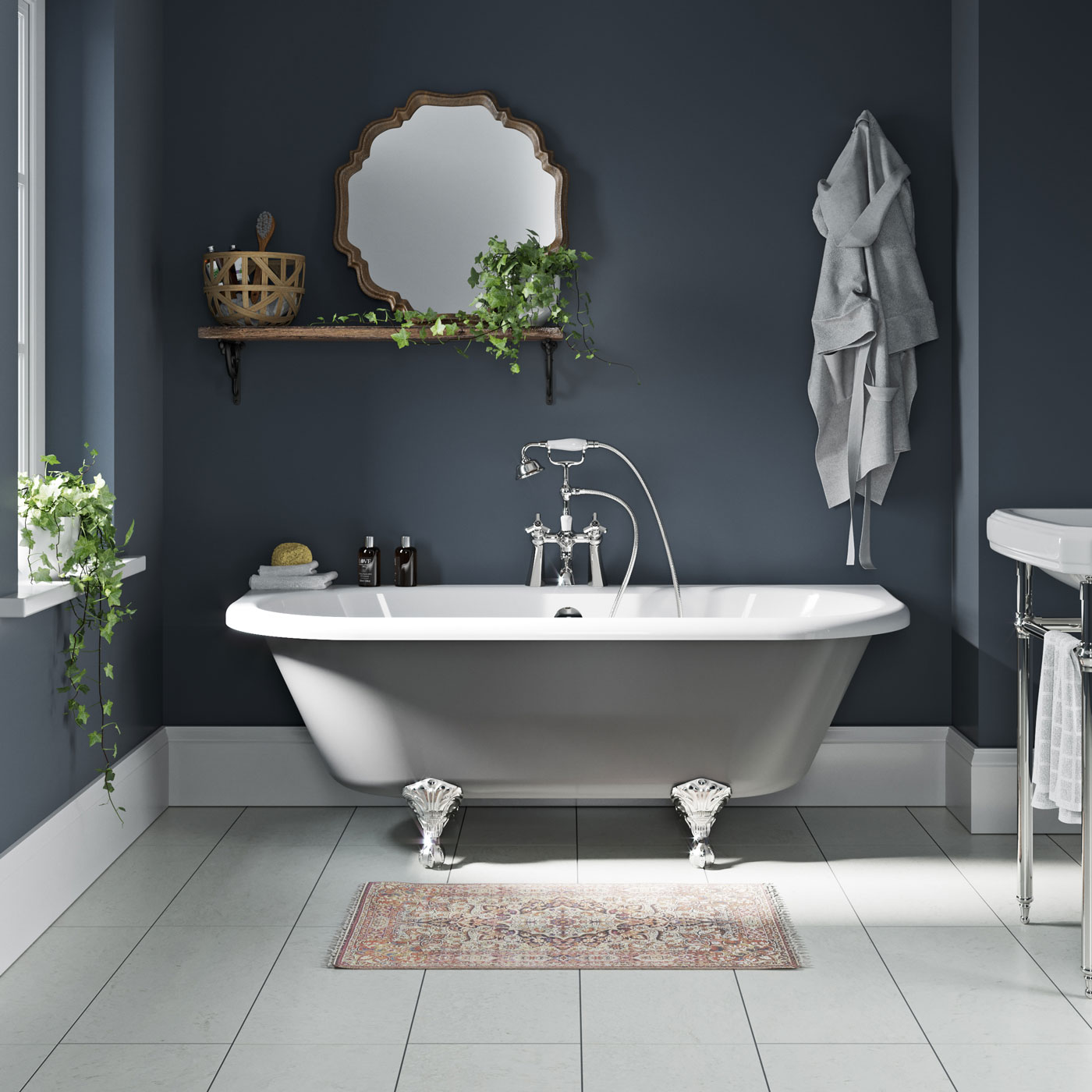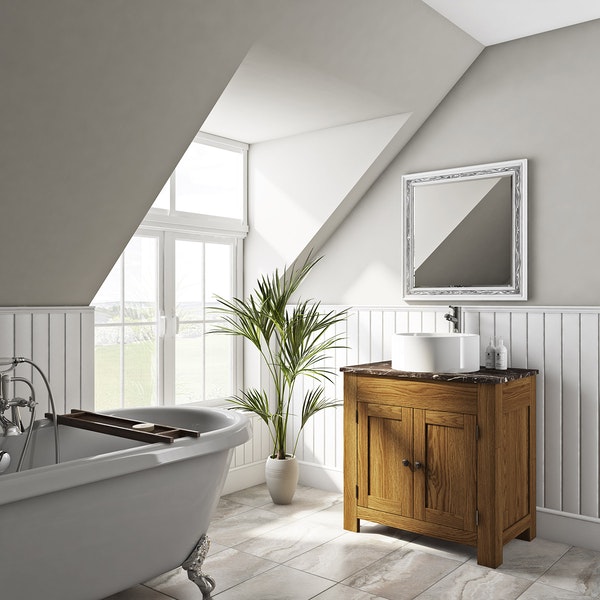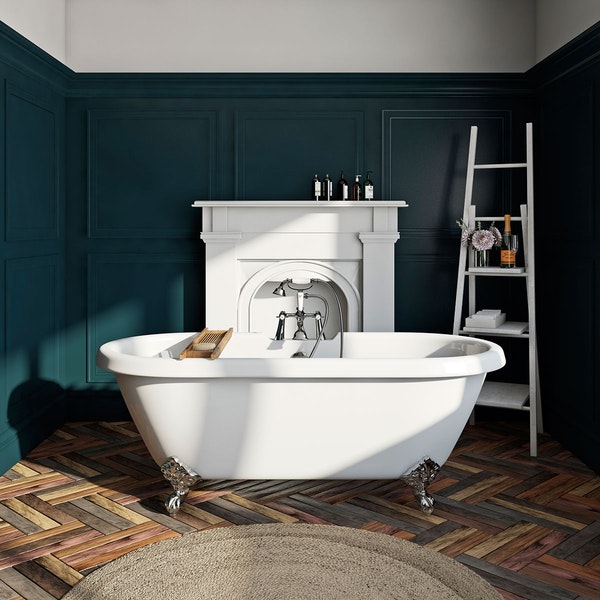There’s nothing quite like a luxurious soak in the tub after a long and hectic day. Unfortunately, most of us take for granted the fact that our bathrooms were thoughtfully designed and created with specific features to achieve ultimate relaxation. But the truth is that the design of a bathroom can be the difference between a soothing sanctuary and an outdated storage room.
To guide you through the maze of possibilities and get the most out of your design choices, here’s a primer on bathtub styles and features, along with their advantages. We’ll look at common styles from corner tubs to stand-alone freestanding models, and discuss the benefits of each. So lean back and relax, we’ve got the perfect bathroom design ideas just for you.
Quick Summary of Key Question
Common bathtub design styles include freestanding tubs, corner tubs, alcove tubs, jacuzzis, and drop-in tubs. Each one of these styles has its own set of benefits depending on the size and layout of your bathroom.
Common Bathtub Designs
Bathtubs come in many shapes and sizes, though some designs are more popular than others. Several types of bathtub designs have become commonplace within modern bathrooms. This article will discuss common bathtub styles and their benefits.
One of the most popular bathtub models is the alcove tub. Often referred to as an “American style” tub, these bathtubs typically have three walls and fit snugly into an alcove or corner of the bathroom. This type of tub maximizes under-the-tub storage while still providing a spacious bathing area. Additionally, they allow for extra safety features – namely, shower doors integrated into the design – with convenience built in.
Drop-in or recessed baths are also gaining popularity due to their modern yet decorative look. These types of tubs are designed to be dropped into a predesigned space in the floor, leaving a raised rim visible above the bathroom’s surface. The benefit here is having a tub that blends in seamlessly with your home’s design scheme, as well as its surrounding tile and furniture pieces.
One downside to alcove or drop-in bathtubs is they require plumbing fixtures that may disrupt some tiling arrangements or require extra plumbing work when installing them. However, no matter what type of sink you choose, ensure that your room has proper ventilation first to avoid any moisture build-up caused by steam from hot baths or showers.
Finally, most bathrooms offer whirlpool/jetted bathtubs for those who prefer spa treatments within their own homes. These tubs employ air and water jets that circulate warm water around you for a sensation similar to massage therapy. The biggest benefit is relaxation: creating an at-home spa experience without ever having to leave your bathroom!
Freestanding bathtubs provide another option for homeowners looking to create an aesthetically pleasing bathroom design while simultaneously taking full advantage of any luxury bathing experience they can offer. The next section will delve into this type of bathtub style and its associated benefits.
Essential Highlights
This text discussed common bathtub styles, their benefits, and drawbacks. Popular designs include alcove tubs, which are great for maximizing storage, drop-in tubs which blend with their surroundings, and whirlpool/jetted tubs which provide a spa experience. For those looking to bring luxury into the home, freestanding bathtubs are an option. Ventilation should be taken into consideration when installing any type of bathtub to avoid steam buildup.
Freestanding Bathtubs
Freestanding bathtubs are a popular choice for bathrooms due to their classic, elegant design and ability to be placed almost anywhere in the room. They provide an eye-catching focal point and offer more flexibility than built-in models. Freestanding tubs come in a variety of shapes and sizes, ranging from traditional claw-foot tubs to modern sculptural designs. Another advantage is that these tubs can easily be relocated without tearing up your bathroom flooring or plumbing.
However, freestanding baths may not be suitable for everyone due to the space they occupy, meaning they may take up a large chunk of your bathroom and limit other furniture pieces you can include. Furthermore, they do require considerable maintenance as part of the cleaning regime as dirt can accumulate around the base quickly. They also usually require additional parts such as wall-mounted shower heads or hand-held shower sprays when being used for showers.
Overall, freestanding bathtubs offer a beautiful design element and flexible placement options for those who want to fully utilize their bathroom space. Nevertheless, it’s important to weigh up all the pros and cons before making a decision. With this in mind, let’s move on to discussing the benefits of built-in bathtubs in the next section.
Built-In Bathtubs
Built-in bathtubs are a classic design option for bathrooms due to their ability to be situated flush with the floor. This creates an unimpeded walkway around the tub, allowing for easy access from any side, and a sleek and modern minimalistic look. Built-in tubs come in a large variety of sizes and depths to suit both space requirements and needs of the individual bather.
The major advantage of built-in tubs is they help to create an open, airy feel in a bathroom by eliminating pesky edges that can catch dirt and bacteria. Additionally, because built-in tubs tend to be quite shallow compared to other styles allowed greater freedom of movement and better access for those who may have difficulty getting in or out of the bathtub.
On the downside, built-in tubs do require more intensive installation due to cutting accurate dimensions into the existing floorboards and caulking along the edges to ensure water tightness. They also tend to be less aerodynamic than alternatives such as free standing models, meaning that it may take longer for the hot water to fill them.
Overall, built-in bathtubs offer some great advantages for personalization, especially when designing around special physical needs or aesthetic preferences. Homeowners should weigh both sides before making final decision between this style and other options.
Next up, let’s explore another classic style of bathtub: walk-in bathtubs.
Walk-In Bathtubs
Walk-in bathtubs are a great option for those looking to increase their overall bathing experience. These tubs feature door systems that allow a person to enter and exit the tub without having to step over a high tub wall. This makes them ideal for those with limited mobility and can make bathing safer while reducing stress on joints and muscles. In addition, most walk-in bathtub doors have air tight seals, allowing them to be filled up to two inches deeper than traditional tubs, creating a more luxurious bathing experience.
One main disadvantage of walk-in bathtubs is that they can be more expensive than other styles due to their extra features. Additionally, the door requires extra space in the room for installation which may require some remodeling or removal of other fixtures such as counters or mirrors. Lastly, because of the added seals around the walk-in door, there may be an increased risk of water leakage if not properly maintained.
Despite these drawbacks, walk-in bathtubs can offer considerable advantages for users with physical limitations as well as an overall higher level of comfort and convenience due to their deeper fill depth. With thoughtful design and quality materials, a walk-in bathtub will provide years of reliable use while enhancing bathroom aesthetics.
Having discussed the benefits of walk-in bathtubs, the next section will explore various design features and quality materials used in modern bathroom remodels.
Design Features and Quality Materials
When considering bathroom design ideas, one of the most important factors is choosing the right design features and quality materials for your bathtub. Every style of tub has its own unique benefits, such as traditional clawfoot tubs offering a heightened level of grandeur and elegance to any bathroom, while freestanding soaker tubs provide ample space and comfort. However, regardless of which style you choose, it is essential to use quality materials that will stand up to daily use and last for years to come.
For instance, materials such as copper are not only durable and low-maintenance but also add an undeniably vintage aesthetic to the bathroom. Stainless steel is another popular option, thanks to its anti-corrosion properties and luxurious brushed finish. Acrylic baths can also be a great choice since they are both lightweight and easy to maintain. Additionally, they have a glossy surface that adds a hint of shine to the room.
The quality of craftsmanship should also be taken into consideration when choosing materials for your bathtub, as there are many inferior options available that may look good at first but won’t age well over time. For maximum long-term durability and quality assurance, choose a material made from durable and non-porous materials like cast iron or stone.
Due to all these considerations, ensuring that you invest in quality materials for your bathtub is essential for creating an aesthetically pleasing yet thoroughly functional bathroom – no matter which style or size you ultimately decide upon.
Now that you know how to choose the right design features and quality materials for your bathtub, our next section will discuss shower options: what type of technology you should look for in order to make your shower as comfortable an experience as possible.
Shower Options
When considering bathroom design ideas, it is important to remember that showers can also be a great way to provide an updated and modern look. Showers provide a minimalistic appeal as well as having some notable benefits that baths do not, such as being much easier to keep clean and conserving water due to shorter shower times over baths. They come in various styles, from floor-level showers constructed from systems of tiles, to tiled cubicles with frameless glass doors or sliding doors, to free standing shower units with glass walls and available in different sizes and materials.
Another advantage of showers is the ability to add customization options like detachable shower heads for flexibility, built-in benches that make it suitable for bathing children or retrieving items. Adding a power or vanity shower enhances functionality and luxury with its adjustable pressure settings or music and light components. There are even multi-headed shower systems available for those who want a high-end spa experience at home.
On the other hand, while showers offer convenience they may not offer the personalized style you’re looking for when designing your bathroom space. They may not be able to fit all the current trends seen in magazine-worthy bathrooms, and may take up more space once additional elements such as curtains or glass doors are installed.
Bath designs have come far from the simple white tub installation in the corner of a room of yesteryears and can often include a range of colours, textures, shapes and sizes to suit any home improvements needs. Now that we have discussed shower options, let’s move onto popular bathtub styles which offer some of the features seen above but with a more traditional feel.
Popular Bathtub Styles
When considering bathroom remodeling or renovations, one of the most important features to consider is the bathtub. Popular bathtub styles can include drop-in, freestanding, clawfoot, and alcove tubs. Each style offers unique benefits that make it a great option for homeowners looking to upgrade their bathroom.
Drop-ins are the most commonly used type of bathtub and are ideal for small bathrooms as they fit perfectly into a pre-existing hole in the floor and walls. Most come with a built-in shower enclosure and allow you to personalize your bathroom decor from the layout of the drain to color and accessories. They can also be framed or surrounded with tile work if desired.
Freestanding tubs offer an aesthetic value not seen with other styles as these free-standing baths come in a variety of modern materials like bronze, metal, acrylic, stone, and more. They draw attention to the corner of a room and makes could be used in combination with traditional fixtures such as a showerhead. Whether you decide on a classic claw-foot design or contemporary egg shape, this style adds substantial elegance to any bathroom.
Clawfoot baths are incredibly versatile pieces, allowing for a lot of customization options sure to please particular tastes. Available in both pedestal and wall mount designs, these fixtures have plenty of depth and width that allows for full body relaxation soaks. Clawfoot models can also come without faucets built in to allow some flexibility when selecting matching taps and accessories.
Alcoves are perfect if you want all your bath hardware (including shower) on one wall while still providing adequate space to get clean efficiently and safely. Traditional tubs set into three walls offer good support but can sometimes take up too much space – an alcove brings a more compact but equally efficient solution in many cases; making them perfect for smaller bathrooms where closeted spaces such as showers cannot be utilized due to lack of room.
Overall, there are plenty of popular bathtub styles available with different benefits that make each one a potentially valuable addition to someone’s bathroom remodel project. The key is choosing one that fits within the space constraints of your home while still bringing an element of beauty and/or luxury alongside essential functionality. With this guide in mind, let’s move onto our next section discussing modern bathtub options available on the market today.
Modern Bathtub
Modern bathtubs come in a wide variety of shapes and sizes and offer many design options for today’s bathrooms. Most modern bathtubs are constructed from high-end materials such as acrylic, stone resin, and cast iron, allowing for smooth finishes, easy maintenance, and durability. Depending on the model chosen, a modern bathtub can add an air of sophistication or sleek minimalism to any bathroom design.
On the other hand, some argue that modern designs are more expensive than traditional designs; however, modern material options are typically much more durable so can last longer with minimal repairs. Furthermore, most modern bathtubs come equipped with a variety of features including built-in seating areas, built-in shelves, jetted hot tubs, and heated surfaces. These features not only provide added comfort but can also increase the value of a home when it comes time to sell.
In conclusion, while there may be a higher initial cost associated with purchasing a modern bathtub, its stylish designs and advanced features make it well worth the investment for those looking to add a touch of elegance to their home’s bathroom design.
Moving on to another prominent style for bathrooms is the traditional bathtub. These classic designs have been staples in homes for decades due to their timeless appeal and reliable performance. In the next section we will discuss in detail the benefits of traditional bathtubs and what makes them so popular among homeowners today.
Traditional Bathtub
When it comes to traditional bathtubs, you can’t go wrong with this classic option. Traditional style bathtubs often feature a rectangular or oval shape, and are made from either cast iron or acrylic. While most traditional style bathtubs are white or light in color, you can easily find different ways to customize the look of the tub through accent pieces like faucets and showerheads. This style is great for those who don’t want to take up too much space in their bathroom since they are typically shorter than other types of tubs.
There are arguments on both sides when it comes to traditional bathtubs. On the one hand, they do tend to be more affordable than some of the newer styles; however, they can also be slightly more difficult to keep clean due to the porosity of their materials. Proper care and maintenance are crucial to keeping these tubs looking their best.
When it comes to bathroom design ideas, garden tubs offer a luxurious spa-like experience at home. This type of deep and wide tub is becoming increasingly popular as homeowners seek out ways to relax and enjoy a long soak after a stressful day. In the next section, we will explore the benefits of a garden bathtub for your home renovation project.
Garden Bathtub
A garden bathtub differs from your typical bathtub in that it features a wide rim and a shallow basin. This design is intended to mimic the peace of soaking in a lush garden, as opposed to merely taking a dip in an enclosed space. Garden tubs come as standalone units or as an offshoot of a shower-and-tub combo. With their unique elongated shape, they can often be difficult to fit into small bathrooms. If you choose to go with this style of bathtub, you’ll want to make sure there is plenty of room to move around your bathroom before committing to it.
The decision to choose a garden tub comes down to individual preference and available space. On the one hand, these luxurious tubs are great for those looking for uninterrupted moments of solitude and relaxation in their bathrooms. They also add an extra dose of luxury and aesthetic charm, making them perfect for providing spa-like vibes in any home’s bathroom. On the other hand, without ample room they can seem out of place, lack functionality, or become impractical altogether. Before deciding on whether or not to include a garden tub in your bathroom design plans, be sure you first weigh all pros and cons of all available options – size and lifestyle included!
Now that we’ve explored some of the common bathtub styles available today, let’s dive into the benefits of each design and learn more about how our bathrooms can benefit from them.
Benefits of Different Bathtub Designs
When it comes to choosing the ideal bathtub design for your bathroom, there are a variety of factors to consider. Each design offers different benefits depending on your personal needs and preferences. In this section, we will explore the different benefits associated with each type of bathtub design.
The classic alcove tub is one of the most common bathtub designs and is characterized by its ability to be easily installed in various bathroom layouts. These types of tubs come in a wide range of shapes and sizes and can be placed directly against any wall. The major benefit of an alcove tub is that they save space while still providing ample room for a good soak.
Freestanding tubs are quickly becoming a popular choice due to their modern style and versatility. Freestanding tubs can be placed virtually anywhere in the bathroom, so you are sure to find one that works well with your existing style and layout. Additionally, because these baths do not require installation against a wall, they can be moved around or relocated to another area if needed.
If you enjoy taking extended baths, the large-sized drop-in tub is an extremely comfortable and luxurious option. Ranging from five to six feet in length, these types of tubs offer enough room for two people for couples who like to bathe together. With drop-in tubs, you also have the option to add jets for hydrotherapy massage capabilities if desired.
Finally, corner bathtubs are designed to maximize space efficiency in small bathrooms as they fit snugly into two walls at once. This type of tub is normally built low to the ground, making it very accessible for those with mobility issues and allows you more standing room when showering than other types of bathtubs. Corner tubs also tend to give off a feeling of spaciousness due to their unique shape since they typically feature curved edges which open up the area around them.
No matter which type of bathtub design you choose, careful consideration should always be taken before any final decisions are made so that your end result perfectly suits both your needs and taste. When deciding on the right bathtub design for your bathroom, it is essential to consider what advantages each style presents in terms of size, budget, installation process, available features, and potential aesthetic appeal. Moving forward we will discuss further how to find the ideal bathtub design for your specific bathroom setup.
Finding the Right Bathtub Design for Your Bathroom
Finding the right bathtub design for your bathroom can be a daunting task. There are so many factors to consider that it is easy to get overwhelmed and stressed. It is important to understand the different bathtub styles available to you, their benefits, and which style will work best in your space.
Drop-in: Drop-in tubs are perhaps the most common type of bathtub on the market. They are popular due to their sleek aesthetic and affordable price point. These tubs are set into a frame or enclosure, typically made of tile or stone. This allows them to blend seamlessly with other bathroom fixtures and makes them easy to clean and maintain. The drawback of drop-in tubs is that they can often be difficult to get into, requiring extra steps like sitting on the edge and swiveling around before entering.
Freestanding: Freestanding tubs give bathrooms a sophisticated, luxurious feel and offer more installation options than drop-in tubs since they don’t need an enclosure or frame. Like drop-ins, these tubs have access from all sides, though some freestanding designs may require wall mountings for stability. The biggest downside to freestanding tubs is cost; free-standing models tend to cost significantly more than their drop-in counterparts, making them inaccessible for many homeowners.
Alcove: An alcove or “three wall” tub is similar in style to a drop-in but is set into the walls on three sides, giving it a built-in look. These bathtubs are relatively inexpensive compared to freestanding models but require significant construction in order to fit the space correctly. Additionally, users will find they have less room within the tub than with other styles, as it is designed primarily for one person at a time.
Corner: Corner tubs are designed to fit snugly against two walls and can save valuable floor space if designed correctly. Despite advantages like space savings and stabilization from walls being built around the base of the tub, corner bathtubs can be quite costly due to their complex designs—creating curved corners rather than just straight surfaces requires extra materials and craftsmanship that adds onto the overall cost of purchase.
When searching for the right bathtub design for your bathroom, consider not only style but also practicality—safety first! Carefully examine each option’s benefits versus drawbacks to ensure you make an informed decision that works best for both your budget and home design skillset.
Responses to Common Questions with Detailed Explanations
What are the most popular bathtub design styles?
The most popular bathtub design styles are alcove, free-standing, drop-in, corner, and whirlpool tubs. Alcove tubs are the most common type due to their cost efficiency, as they fit directly against two walls for easy installation. Free-standing tubs offer a more modern aesthetic with a range of shapes and sizes available. Drop-in tubs create an understated look with the ability to customize a tile surround or deck area. Corner tubs provide an easy solution for small bathrooms that still provide a full size bathing experience. Whirlpool tubs offer the ultimate in relaxation with massage jets and calming water features.
What should I consider when deciding which bathtub design style is right for me?
When deciding which bathtub design style is right for you, consider both practical and aesthetic factors. Think about the size of your bathroom area and how much space you need for a tub. Consider also the amount of water pressure needed to fill it quickly as well as your budget for installation.
Aesthetically, look at various bathtub designs – from traditional freestanding models to contemporary or modern design, or whirlpool or Jacuzzi tubs – and decide which appeals most to you. Also evaluate certain materials, such as porcelain on steel, fiberglass composite units or custom stone creations, to determine which material type fits best within your bathroom’s overall design.
No matter which bathtub design style you choose, be sure that it meets any safety requirements in terms of non-slip surfaces and easy entry/exit features. Your selection should not only satisfy your comfort needs but also fit within your overall decorating scheme.
What are the benefits of each bathtub design style?
The most popular bathtub designs are freestanding, alcove, drop-in, corner, and platform. Each design style offers various benefits.
Freestanding tubs are a popular option because they provide a bold focal point in the bathroom and can be set up on any type of flooring. They come in a variety of materials and shapes. Some freestanding designs even include jets for a spa-like experience.
Alcove tubs are typically installed within a three-sided cabinet space created between walls or against one large wall. The benefit of this design is that it provides containment when needed, such as when bathing small children or pets. They also have the added convenience of rarely requiring additional fixtures except for a shower head if desired.
Drop-in tubs are inserted into an existing frame or enclosure and rest at ground level inside the frame. The main advantage with this design is that it provides easy access to bathers since there’s no need to step into the tub and it works well with minimalistic decor styles.
Corner tubs come in both freestanding and built-in models and provide ample room for two bathers to bathe together in comfort. This type is perfect for couples seeking to enjoy some luxury after a long day. Additionally, it helps maximize limited space in smaller bathrooms.
Platform tubs are stand-alone pieces elevated on either a platform or a custom enclosure which gives them more presence in their surroundings than traditional bathtubs. There are usually many customization options available with this style to create either an ultramodern look or something more classic.

